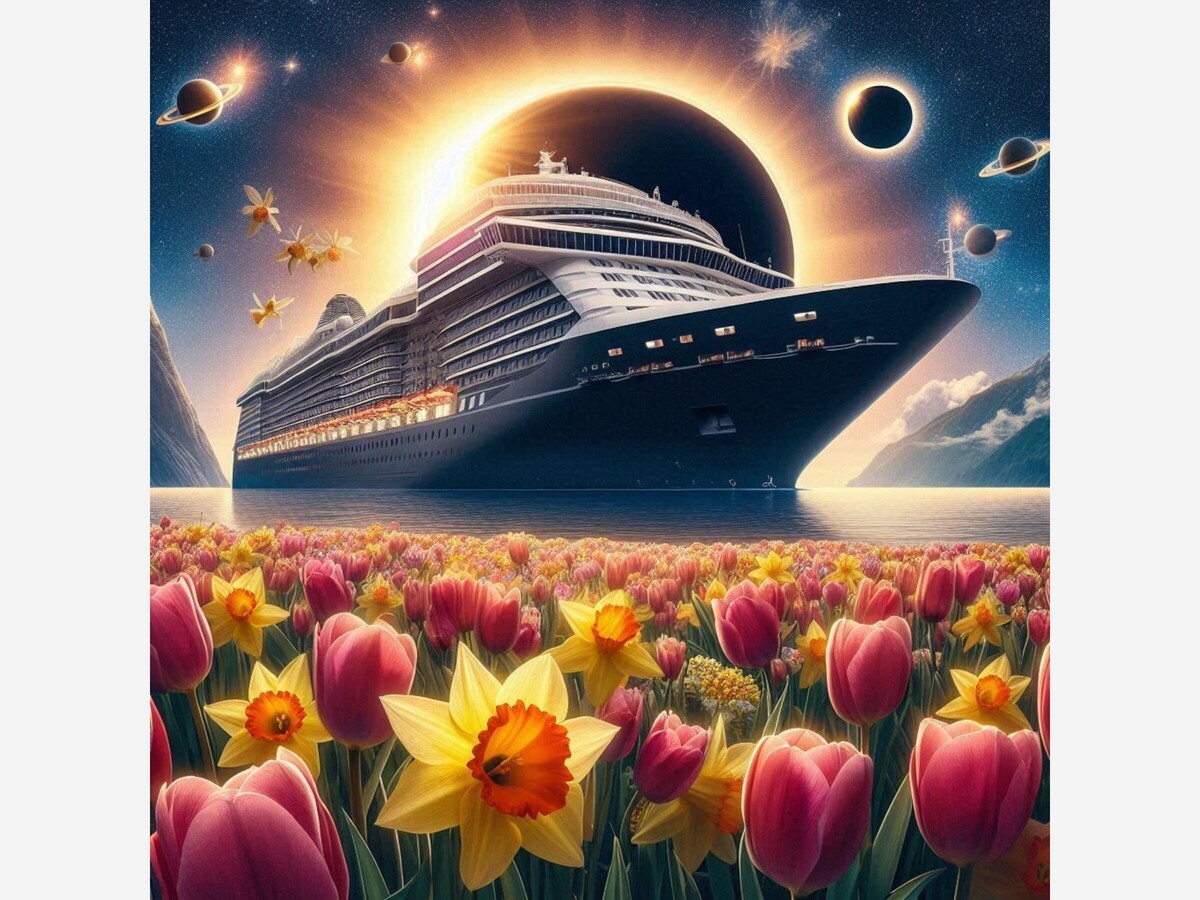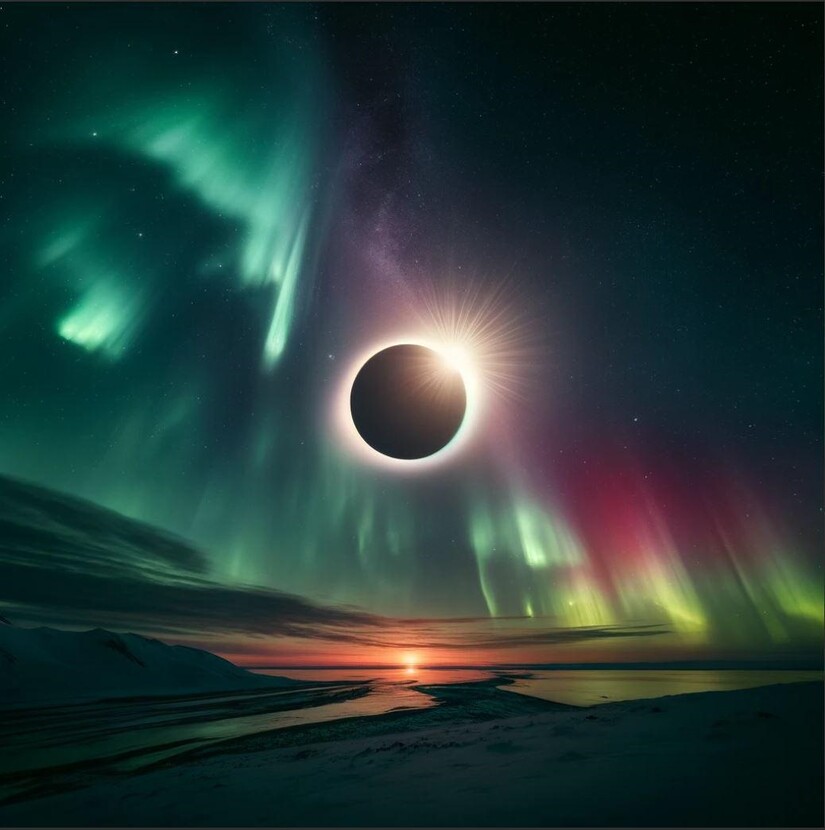Image

By Dr. Anton Anderssen
The oldest eclipse record is found on a clay tablet uncovered in the ancient city of Ugarit, in what is now Syria, with two plausible dates usually cited: 3 May 1375 BC or 5 March 1223 BC, the latter being favored by most experts on the topic. Since antiquity, eclipses have been considered amazing events.

The last total solar eclipse visible from Indiana (my childhood home) occurred on June 8, 1918. I wasn’t born yet. On March 7, 1970, Indiana experienced a partial solar eclipse. I was in the fourth grade. Michael Kendrick taught me how to view the eclipse using a shoebox and blank piece of paper. He also told me there would be a total solar eclipse in 2024. I would have to wait 54 years if I wanted to see it. I thought about traveling “Back Home Again In Indiana” (that’s the song they sing at the Indy 500) to see the 2024 eclipse, but April can be a very rainy month in the Midwest.
We determined Mazatlán would be an excellent choice, since it was in the path of totality, and it’s situated in a desert. But when I tried to book hotel space, hotels were wanting $5000 US per night during the spectacle. Then I discovered Holland America had an affordable solar eclipse cruise that would chase the eclipse at sea, off the coast of Mexico. I was thrilled!

Setting sail with Holland America Cruise Lines on our recent total solar eclipse expedition was an experience beyond compare. From the moment we stepped on board, we knew we were in for something extraordinary. As seasoned cruisers, my hubby and I had high expectations, but Holland America exceeded them in every possible way.

We embarked at the port of San Diego, but we flew from Honolulu on Alaska Airlines two days early and stayed in Old Town. Old Town San Diego is a vibrant and historic neighborhood that serves as a delightful blend of cultural attractions, charming shops, delicious dining options, and immersive experiences. Stepping into Old Town feels like taking a journey back in time to the early days of San Diego, where the sights, sounds, and flavors of the past come alive.
Holiday Inn Old Town is close to both the airport and cruise terminal, and they provide a free shuttle to and from each. Since I use an electric wheelchair, they chartered an ADA shuttle with a wheelchair lift at no cost to me for transfers. When we arrived at the cruise terminal, it was pouring rain, so the port authority accommodated me by allowing my ADA shuttle to drop us off in a covered area, so the electronic circuitry in the wheelchair would not risk water damage.

Our first port of call was Cabo San Lucas. One of the most popular tourist attractions in Cabo San Lucas is the iconic natural rock formation known as El Arco de Cabo San Lucas, or simply "El Arco." This majestic arch-shaped rock formation emerges from the sea at the southern tip of the Baja California Peninsula, where the Pacific Ocean meets the Sea of Cortez. El Arco is not only a stunning natural wonder but also serves as a symbol of Cabo San Lucas itself.
Visitors to Cabo often embark on boat tours or water taxis to get up close to El Arco, where they can marvel at its grandeur and take memorable photographs. Since this was a tender port, Holland America navigated its tenders so we got up-close views of El Arco as a special treat..

Our next port of call was Mazatlán. One of the most popular tourist attractions in Mazatlán is the Historic District, also known as Centro Histórico or Old Mazatlán. This charming neighborhood is renowned for its rich cultural heritage, stunning architecture, and vibrant atmosphere. Dominating the skyline of Old Mazatlán is the Cathedral Basilica of the Immaculate Conception, a stunning example of neoclassical architecture. Built in the late 19th century, this magnificent cathedral features ornate altars, beautiful stained-glass windows, and a towering bell tower. Visitors can explore its interior, attend Mass, or simply admire its grandeur from the outside. Two blocks behind the cathedral is Mercado Pino Suarez, a bustling market where vendors sell everything from fresh produce and seafood to handicrafts and souvenirs. We meandered through the maze of stalls, buying embroidered tote bags which were far cheaper than identical bags in Cabo. We also went to one of the many pharmacies and purchased meds I use for diabetes. No prescription was required, and the prices were very low.

But the true highlight of our voyage was, without a doubt, the total solar eclipse event at sea. As the much-anticipated day approached, the excitement among passengers reached a crescendo. Holland America pulled out all the stops to ensure that we had the best possible experience. Our ship, the Konigsdam, had renowned astrophysicist Dr. Adam J. Burgasser on board, who gave exciting lectures about celestial wonders. I had seen this professor on YouTube before, as his videos come up when one is watching similar presentations by "Sexiest Astrophysicist Alive" Neil deGrasse Tyson, and theoretical physicist Brian Green, a professor of physics and mathematics at Columbia University, as well as being serious eye candy.

Professor Burgasser gave many lectures, exciting every astronomy enthusiast on board. He is known mostly for his research on brown dwarfs. When the daily program listed a lecture on brown dwarfs I was thrilled because I already have a huge collection of troll dolls and gnomes – brown dwarfs would be a wonderful addition to my menagerie.

I’m just pulling your leg. I’m the Vice President of Mensa Hawaii, and I’ve studied astronomy and astrophysics. Let me explain: Imagine stars as giant balls of gas, mostly hydrogen and helium, that shine because of nuclear reactions happening at their cores. Now, brown dwarfs are like the runts of the stellar litter. They're not quite big enough to become full-fledged stars, so they never start those nuclear reactions in their cores.
Because they don't have those reactions, they don't shine like stars. Instead, they give off a dim glow, which is why they're called "brown" dwarfs. They're kind of like a "failed" star, not quite making it to the stellar big leagues but still hanging out in space, doing their thing. They're not hot enough to shine brightly like stars, but they're not cold like planets either. They're sort of in-between, which makes them fascinating objects to study in astronomy. With a regular optical telescope (one that observes visible light), detecting brown dwarfs directly can be quite challenging because they emit most of their light in the infrared part of the spectrum. Dr. Burgasser brought slides of brown dwarfs taken from the Webb telescope. The James Webb Space Telescope (JWST) is a powerful space observatory designed to study the universe in infrared wavelengths. It's often considered the successor to the Hubble Space Telescope, although it has different capabilities and focuses on different parts of the electromagnetic spectrum. His lectures were amazing because Holland America’s Konigsdam has a stage with enormous panoramic screens allowing for 180-degree views. It was like being in space.

Then came the big day. Special viewing areas were set up on deck 10. Holland America gave us paper souvenir solar eclipse glasses for the three-hour event. But TMobile was giving away BodyGlove sunglasses with flip-down solar visors which are sturdy and designed to last. Every Tuesday, TMobile gives away some kind of little gift to its customers.

We found a comfortable place on Konigsdam’s deck 10 to watch the main event. When the moment finally arrived, it was nothing short of breathtaking. As the moon slowly crept across the face of the sun, casting its shadow over the ocean, there was a hush of anticipation that swept through the ship. And then, as totality enveloped us, the sky transformed into a canvas of otherworldly beauty. The sight of the sun's corona shimmering in the darkness was a sight that will stay with us forever—a moment of pure magic that words cannot adequately describe. At totality, we could see the moon, several stars, and Jupiter to the left, with Venus to the right. Some people with specialty telescopes could see Comet 12P Pons-Brooks. Professional astrophysicists in Mazatlán were able to image Kreutz sungrazer Comet SOHO-5008, which met its doom just 12 hours after the eclipse. Nobody knew SOHO-5008 was going to be a visitor to the spectacle. It was discovered only a few hours beforehand by satellites.

But our eclipse and celestial delights were just part of the many highlights of our Holland America cruise. Throughout the journey, we were treated to a wealth of experiences that left us in awe. From the exquisite dining options to the world-class entertainment, every moment onboard was a delight for the senses. And the service? Impeccable, as always.

Our ship continued to tour the Hawaiian Islands. Since we live there every winter, there wasn’t anything we felt we needed to see. We did schedule a biopsy surgery for my hubby, after an MRI showed tumors in his prostate. We spent the Honolulu port day at Queen’s Hospital, so Dr. Sergei Tikhonenkov could take 18 samples. Fortunately, every sample turned out to be benign, which was a great relief for us.
Speaking of queens, Máxima Zorreguieta Cerruti, an Argentine, now Queen Consort of The Netherlands, christened our ship, the Konigsdam. "Konigsdam" is a term that appears to be a variation of the German word "Königsdam." In German, "König" means "king" and "dam" is likely derived from "dame," which can mean "lady" or "queen." Therefore, "Königsdam" could be interpreted to mean "King's Lady" or "King's Queen." Since the king of The Netherlands is head of The House of Orange, Holland America salutes the royal family by incorporating the word “orange” and the color orange into themes on its ships. One day is set aside on cruise itineraries to wear orange attire or accoutrements. We wore bright orange lei for the occasion. There is a stunning portrait of King Willem-Alexander and Queen Máxima near Guest Services.

And speaking about Guest Services, we had a problem while in port at Honolulu. I tried to take my medical equipment and some unneeded aloha clothing back to our house in Waikiki, which was just blocks away, but security would not let us leave with our suitcase holding our belongings. Security said I had to have a clearance from immigration, although we passed immigration in Kailua-Kona 3 days ago. At Guest Services, they also denied us permission to remove our bag, citing immigration was not present to inspect it. This was medical equipment that had to be sterilized, and the ship did not have an autoclave or other method to sterilize our devices. After an hour of trying to reason with the staff, I had to get an officer involved to enforce my rights under the Americans With Disabilities Act (ADA) and Wet gelijke behandeling op grond van handicap of chronische ziekte (WGBH/Cz), a Dutch law which protects handicapped people on vessels sailing under a Netherlands flag. It was stressful and unnecessary, in my opinion, to prevent a person in a wheelchair from taking medical and personal items off the ship, especially since I already cleared immigration in Kona. The officer, fortunately, over-ruled everyone else’s denials, and carried my suitcase of medical equipment to the gangway for me.
Except for the medical equipment problem, I would rate this cruise a perfect 10 out of 10. I think the staff need more training when it comes to accommodating disabled people under the ADA and WGBH/Cz.

All in all, we couldn't help but feel a profound sense of gratitude for the memories Holland America had created for us. Holland America had not only fulfilled our dreams of witnessing a total solar eclipse at sea but had also exceeded our expectations in so many ways. It's a journey we'll cherish for a lifetime—a voyage of discovery, wonder, and sheer joy. Plus, we received a bronze medal for being a repeat client of Holland America.

I can only hope that Holland America journeys to Iceland for the August 12, 2026 solar eclipse. During totality, there is a possibility of seeing both the eclipse and aurora borealis at the same time. That would be the thrill of a lifetime.

Follow the author, Dr. Anton Anderssen on X @hartforth
Photo credits: Marco Airaghi and Bing AI
Anton Post is part of Patch Media, which attracts an average of 23.5 million unique visitors monthly.